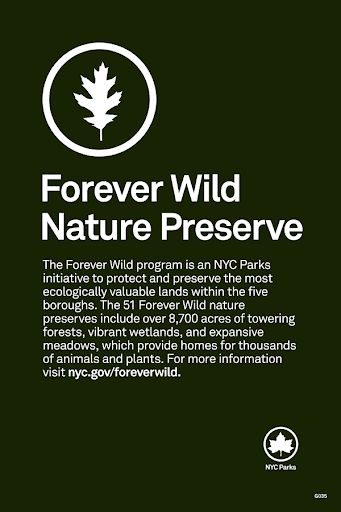Natural Areas Restoration
Van Cortlandt Park contains roughly 640 acres of land protected under New York City’s Forever Wild Program. This section of the park consists of mixed-deciduous forests, small upland meadows, vernal pools, forest streams, a pond, and more! It is a home or refuge for a biodiverse community of flora and fauna. Alongside New York City Parks, the Van Cortlandt Park Alliance is dedicated to managing the natural areas of Van Cortlandt Park to promote the health of this important ecosystem for future generations.
Van Cortlandt Park Habitats
Forest
Van Cortlandt Park’s forest is divided into sections by highways. The Northwest Forest boasts tall and mature oak and tuliptree stands growing within valleys and rocky ridgelines and is a perfect habitat for large birds like great-horned owls and pileated woodpeckers. Giant American sycamores and black walnuts grow among a sugar maple stand in the Croton Woods, where spring ephemerals such as Dutchman’s breeches, trout lily, bloodroot, and cut-leaved toothwort color the forest floor during the early spring. The mockernut and pignut hickories stand among northern red oaks in the uplands of the Northeast Forest, where red-backed salamanders can be found under log or rock. The dry eastern slope of Vault Hill is home to a large stand of sassafras that live among the towering black and white oaks.
Wetlands
Pumpkin ash and black ash trees can be found in the forest swamp of the Jerome Wetland in the southeast corner of the park. A large vernal pool in the Northeast Forest with red maples and sweetgums in the canopy is home to a population of spring peepers heard singing during the early spring months. The largest wetland of all within the park can be found in the Southwest section of the park, the Tibbetts Brook Wetlands. This low lying area was once a floodplain to Tibbetts Brook, and now large pin oaks can be found among stands of cattails and willows.
Meadows
Two maintained meadows occur in Van Cortlandt Park. The upland meadow of Vault Hill is well drained and home to a variety of forbs and wildflowers such as little bluestem, switchgrass, panicled tick-trefoil, and round-headed bush clover. The ant community found within the Vault Hill meadow differs from that found anywhere else in the park. The wet meadow in the Southwest section of the park contains such species as eastern gamagrass, northern blue flag, and New York ironweed.
Pond & Brook
Tibbetts Brook is a slow moving river that begins in Yonkers and flows through the center of Van Cortlandt Park. It opens up into 16 acre Hester & Piero’s Mill Pond at the southern end of the Park (formerly known as Van Cortlandt Lake). The water from the pond currently enters into the city sewer system. The pond and brook are home to fish such as largemouth bass, golden shiner, and brown bullhead. Dragonfly and damselfly species like the green darner and fragile forktail live the larval stages of their lives in the waters and as adults hover above it. Painted turtles, common snapping turtles, and American bullfrogs can be found along the fringes.
Restoration and Maintenance
Forest Maintenance
VCPA works alongside NYC Parks to maintain this precious resource. Our Natural Areas Stewardship team works within multiple sites that span throughout the park, with much of the work focused on non-indigenous plant removals. These invasive plant species have the capabilities of reducing the health and biodiversity of our forests through competitive measures and disrupting the forest community in place. Review our Forest Action Plan to learn more about our plans for forest maintenance between the years 2022 and 2026.]
Pond Management
Water chestnut (Trapa natans) can be found on the surface of Hester & Piero’s Mill Pond every summer. This non-indigenous invasive plant creates large mats, blocking sunlight from reaching further into the water, limiting the growth of other plant species. When the mat of water chestnut dies, aerobic microorganisms begin breaking down the plant matter, limiting the dissolved oxygen in the pond. This reduction in oxygen can cause fish to die off suddenly. Since its formation, VCPA has led efforts in manually removing this detrimental plant species from the pond.
Daylighting Tibbetts Brook
VCPA has been instrumental in advocating for this green infrastructure project that will transform the park and the lives of residents who live on its perimeter. At the southern end of Hester & Piero’s Pond, Tibbetts Brook enters the Broadway sewer at a rate of 4 to 5 million gallons of water per day. That is on a dry day! This water is then treated at the Wards Island Stormwater Treatment Plant. Often when it rains, a combination of sewage, street runoff, and freshwater from the brook enter the combined sewer, bypassing the treatment plant and flowing directly into the Harlem River. This one Combined Sewer Overflow (CSO), WI-056, connected to the Broadway sewer, makes up more than half of the CSO water entering the Harlem River. Daylighting will remove this clean water from the sewer and help to reduce CSO occurrences on the Harlem River and help with flooding issues along Broadway and other areas of the Tibbetts Brook Watershed.
Thanks to the advocacy of VCPA, BCEQ, and the Coalition for Daylighting Tibbetts Brook, a surface level “open channel” daylighting project that includes an extension of the Putnam Greenway to the south, onto unused railroad property (owned by CSX), has been funded. VCPA is working closely with the NYC Parks and NYC Department of Environmental Protection as they plan this project.
Check out this short video from BronxNet and read several newstories to learn more about daylighting of Tibbetts Brook.
Getting Involved
Want to join VCPA’s conservation efforts in the natural areas of Van Cortlandt Park?
We host volunteer events weekly on Wednesdays and Fridays, where community members can assist staff in maintaining this essential ecosystem.
Check out our Calendar of Events page to see what we have coming up, or visit our Volunteer Page for more information.




